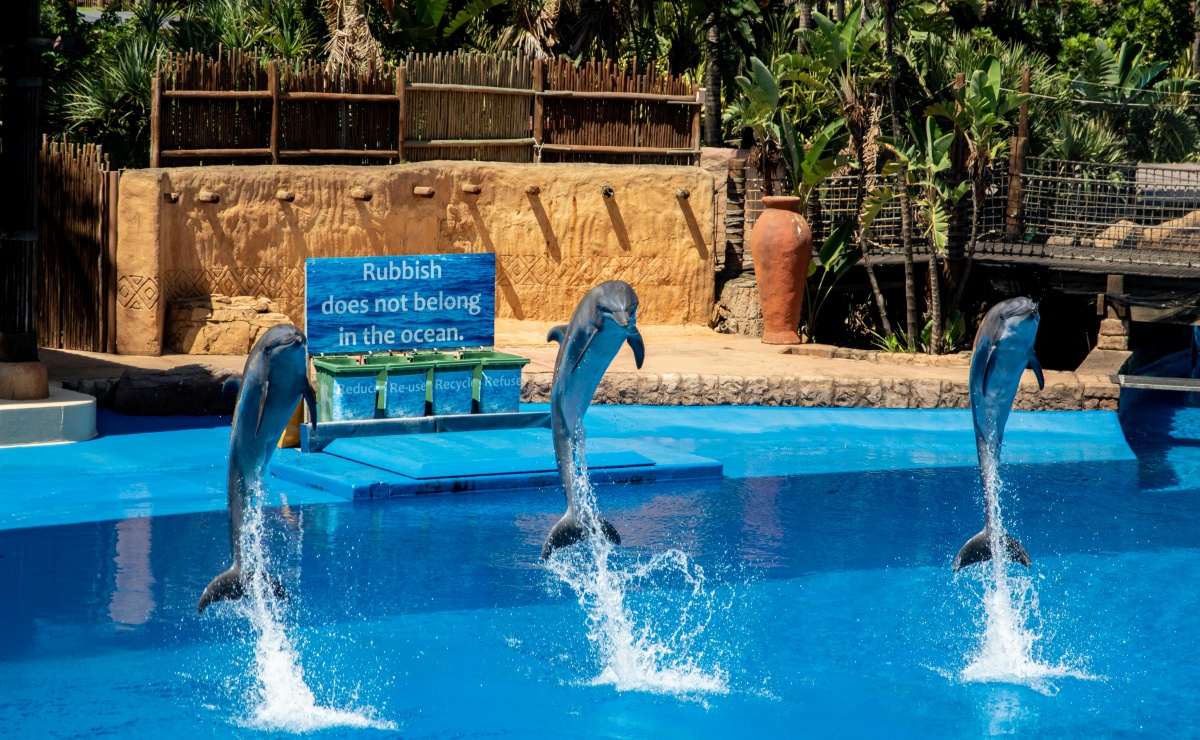Circuses
Circuses keep animals in small cages, which can last up to 23 hours per day. At times, they have the potential to be chained and caged as well. The animals are restricted in their ability to express natural behaviors. Also, living on the road as the circus travels to different places to perform means repeated transport in confinement for these animals.
While circus promoters claim that trainers use only ‘positive reinforcement’ methods (rewards) to train animals, animal protection investigations document a different picture. Circus training methods still involve the use of fear, submission, deprivation, and physical punishment. Animal abuse includes beating and whipping them, as well as depriving them of food. Trainers have the ability to strike elephants with sharpened hooks, which can lead to physical injuries. To maintain their position of dominance, trainers often resort to brutal methods. Yet wild animals will always behave in instinctive and unpredictable ways and cannot be made willing or safely manageable through training. Regular and competent veterinary care is often not provided by many circuses. Animals who are not obedient or have grown too old to perform may be sold or given to zoos. Roadside attractions, research laboratories, or private individuals are unlikely to improve their quality of life. A negative educational message is conveyed in circuses, just like in zoos. Observing wild animals.
Performing unnatural tricks outside their natural habitats does not teach children anything about animals. By displaying bears as tricycle-riding caricatures and dressing elephants in tutus, circuses present animals as creatures whose purpose is to amuse us. creatures that have an intrinsic value and their own nature and behavior.
Canned Hunting
Even more bizarre and cruel than normal hunting, canned hunting involves the killing of an animal in an enclosure to obtain a trophy. The animals can be tame exotic mammals at times. These animals do not know how to run away from humans. There are both captive wild animals and purpose-bred wild animals. Some canned hunting operations purchase items from zoos. Canned hunting is considered unsportsmanlike by many groups that support hunting. Patrons are guaranteed a kill, but some with little aptitude or experience of hunting take this option, leading to wounding and casualties in the attempted kill. Several states in the USA now ban canned hunting operations, but the practice is spreading. South Africa is also where it is performed
Dancing Bears
Dancing bears face numerous welfare issues. Bear cubs are usually taken from the wild and their mothers are usually killed. Wild populations of bears, such as sloth bears, which are threatened in certain regions of India, are affected by this. Then the muzzle is pierced (without anaesthetic) and a tether is inserted to allow the bear to be controlled. The process’s acute pain and distress becomes chronic. The animal must endure lifelong discomfort from a non-healing wound in the mouth, which it must endure for the entire duration of its life. It is then subjected to cruel training methods, and a lifetime of captivity and forced performance.
Racing
Racing is another example of humans using animals solely for entertainment and pleasure. Gambling on the race’s outcome is the main source of enjoyment. Buffalo racing, camel racing, dog and horse racing, etc. are all activities outside the normal expectation for wild animal equivalents of domesticated species. Steeplechases and other horse races are closely linked to hunting and can have large jumps that can result in falls, injuries, and deaths for horses. Two notable examples are the UK’s Grand National and the Great Pardubice steeplechase in the Czech Republic. There are also reports of harsh training methods and performance-enhancing treatments (such as drugs, electrical stimuli, whips, etc.), as would be expected with so much money at stake. Then, animals that do not meet performance expectations are disposed of. Some horses may go to a good home, but many animals are simply killed.
Animal Rides
In many states, animal rides are a common sight. Elephants, camels, and horses are used for this. Cubs are typically separated from their mothers within the first few hours of birth to become accustomed to being handled by people. They are also required to perform tricks. At times, toxic paints are used to enhance the attractiveness of these animals. The animals used for these events are often fed improperly and chained. They are designed to wear equipment for humans to sit on, but it is often poorly fitted. At times, this equipment can penetrate their skin and cause injuries and infections. They are designed to carry an excessive amount of load even if they are tired or have sore feet. Animals such as elephants are also kept in some temples. Elephants need a large space to live and move, but they are often held captive in such cases. The animals are scared when several people try to touch them.




